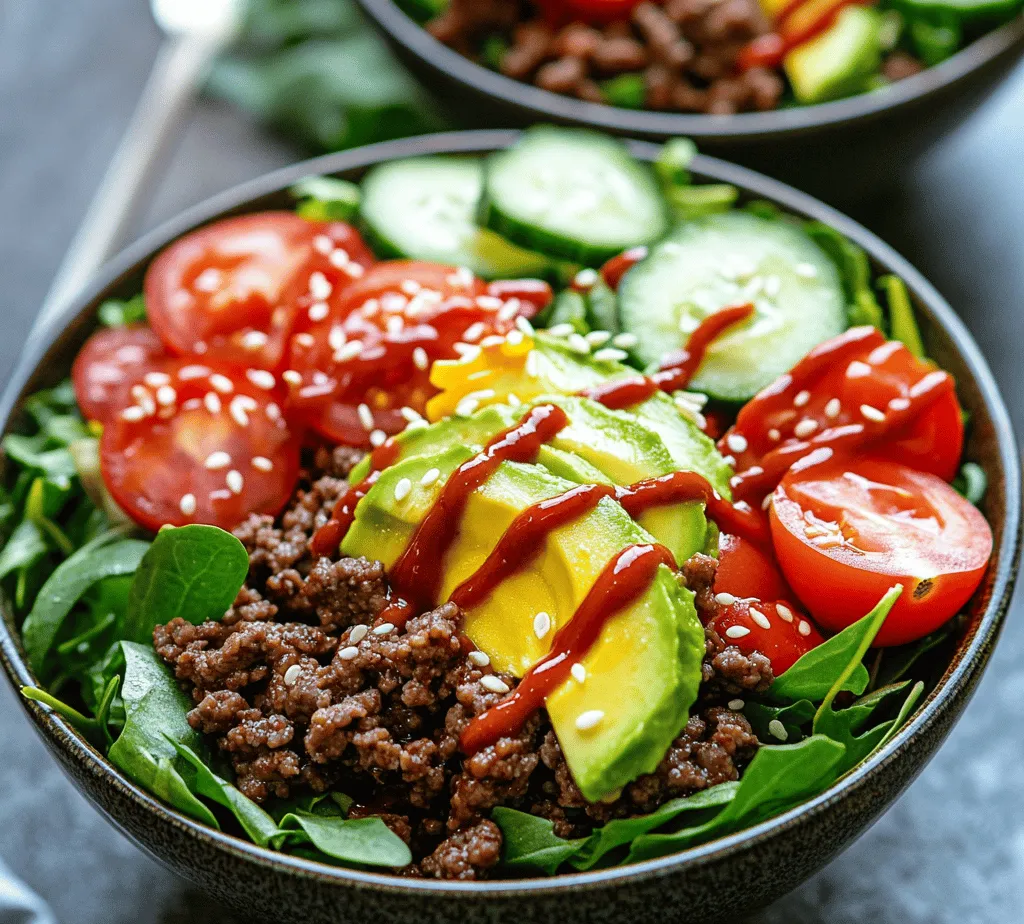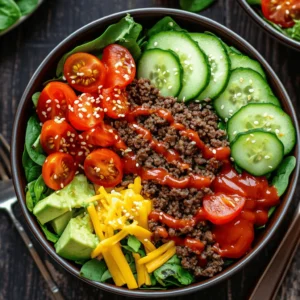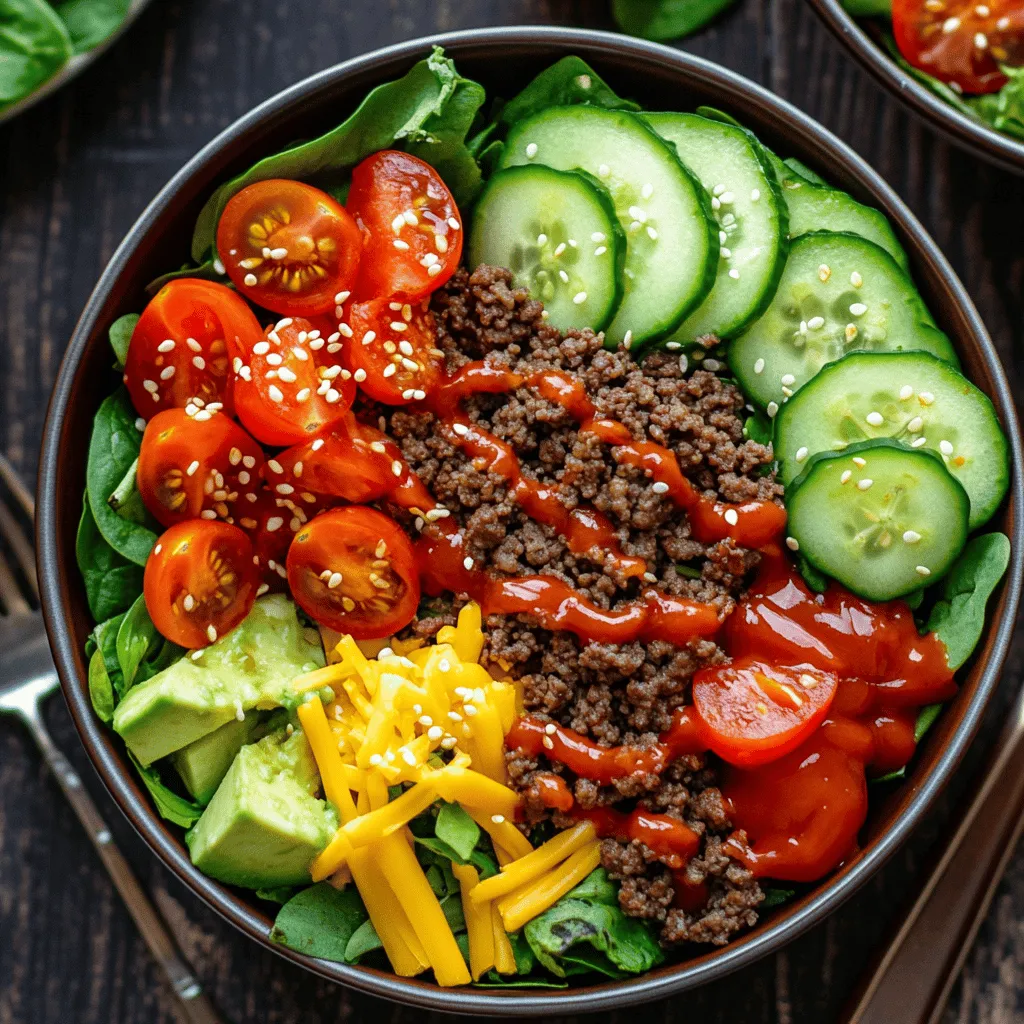Introduction
In recent years, the culinary landscape has witnessed a surge in creative and healthy adaptations of classic comfort foods. Among these, burger bowls have emerged as a popular choice for those seeking to enjoy the beloved flavors of a traditional burger without the guilt. Imagine savoring the juicy essence of a burger, but served in a vibrant bowl filled with fresh, nutritious ingredients. This article will delve into the concept of burger bowls, explore their health benefits, and provide a comprehensive guide on how to prepare this delightful dish.
Burger bowls offer an innovative way to indulge in the rich flavors of a burger while embracing a healthier lifestyle. By swapping out the traditional bun for a bed of greens and other wholesome ingredients, burger bowls not only reduce the calorie count but also pack in essential nutrients. This makes them an appealing option for anyone looking to enjoy a satisfying meal without compromising on taste or nutrition.
In this article, we will cover the fundamentals of burger bowls, including their definition and rising popularity, a comparison with traditional burgers, and the versatile nature of this dish that caters to various dietary preferences. We will then dive into the essential ingredients that make up a delicious burger bowl, highlighting their health benefits and offering insights into flavor pairings. Finally, we will provide a step-by-step guide on how to prepare burger bowls, starting with the cooking process of the ground meat to achieve the perfect texture and flavor.
Understanding Burger Bowls
Definition and Rising Popularity
Burger bowls are essentially deconstructed burgers, offering all the familiar flavors and ingredients of a traditional burger, but presented in a bowl format. This innovative dish allows for a creative twist on the classic, making it a favorite among health-conscious eaters and food enthusiasts alike. The trend has gained momentum in recent years, particularly as more people gravitate towards low-carb, gluten-free, and customizable meal options.
The beauty of burger bowls lies in their flexibility. They can be tailored to suit individual tastes and dietary needs, making them a versatile choice for families, meal preppers, and anyone looking to enjoy a delicious meal without the hassle of traditional burger assembly. Whether you’re a meat lover, vegetarian, or vegan, there’s a burger bowl variation for you.
Comparison with Traditional Burgers
When comparing burger bowls to traditional burgers, the nutritional benefits become evident. Traditional burgers are often accompanied by a high-calorie bun, which can add unnecessary carbs and sugar to your meal. In contrast, burger bowls provide a base of fresh greens or vegetables, significantly enhancing the nutrient density of the meal. This shift not only lowers calorie intake but also offers a wealth of vitamins, minerals, and fiber that are crucial for maintaining a healthy diet.
Moreover, burger bowls are incredibly convenient. They eliminate the need for utensils and can be eaten on the go or enjoyed at home with minimal fuss. The ease of preparation and the opportunity for customization make burger bowls a practical solution for busy lifestyles, allowing you to enjoy a wholesome meal without sacrificing flavor or satisfaction.
Versatility for Various Dietary Preferences
One of the most appealing aspects of burger bowls is their versatility. They can easily accommodate a variety of dietary preferences, making them suitable for everyone from meat lovers to vegetarians and vegans. For instance, those who prefer leaner protein options can substitute ground beef with turkey or chicken, while plant-based eaters can opt for lentils, black beans, or plant-based meat alternatives.
Additionally, the choice of toppings and dressings can be tailored to meet specific dietary needs. For example, individuals following a low-carb diet can skip the starchy ingredients and load up on extra vegetables, while those seeking a protein boost can add nuts, seeds, or legumes. This level of customization ensures that everyone can enjoy the delicious flavors of burger bowls while adhering to their dietary requirements.
Ingredients for Burger Bowls
Overview of Main Ingredients and Their Health Benefits
Creating a delicious burger bowl starts with selecting the right ingredients. The foundation of any burger bowl typically includes a protein source, fresh vegetables, and flavorful toppings. Here’s a breakdown of the main ingredients commonly used in burger bowls, along with their health benefits:
1. Protein: The heart of any burger bowl, protein can come from various sources including ground beef, turkey, chicken, or plant-based options like beans or tofu. Protein is essential for muscle repair and growth, and it helps to keep you feeling full and satisfied.
2. Fresh Vegetables: A colorful array of mixed greens, tomatoes, cucumbers, and any other vegetables you prefer not only adds visual appeal but also enhances the nutritional value of the dish. Leafy greens are rich in vitamins A and C, while tomatoes provide antioxidants like lycopene. Adding a variety of vegetables ensures a diverse intake of nutrients.
3. Cheese: While cheese is optional, it can add a delightful creaminess and rich flavor to your burger bowl. Traditional cheddar cheese is a popular choice, but there are also many alternatives available, including goat cheese or dairy-free options made from nuts, which can cater to different dietary preferences.
4. Condiments: The right condiments can elevate the flavor profile of your burger bowl. While classic ketchup and mayonnaise are standard choices, consider healthier substitutes like Greek yogurt or avocado for a nutritious twist. You can also experiment with homemade dressings to control the ingredients and flavors.
Ground Beef vs. Turkey: Nutritional Comparisons and Flavor Profiles
When it comes to choosing the protein for your burger bowl, both ground beef and turkey have their own unique benefits. Ground beef is known for its rich flavor and juiciness, making it a classic choice for burger enthusiasts. However, it can be higher in saturated fat and calories, depending on the cut used.
On the other hand, ground turkey is often praised for being a leaner alternative, which can be beneficial for those looking to cut back on fat intake. It has a milder flavor than beef, allowing it to absorb seasonings and spices effectively. When selecting ground turkey, opt for lean or extra-lean varieties to maximize health benefits without sacrificing taste.
Ultimately, the choice between ground beef and turkey depends on your personal preference, dietary goals, and flavor profile you desire in your burger bowl. Whichever option you choose, be sure to season it well to enhance the overall taste of the dish.
Importance of Fresh Vegetables
Fresh vegetables play a pivotal role in the preparation of burger bowls. Not only do they contribute essential vitamins and minerals, but they also provide texture, color, and a refreshing crunch that complements the heartiness of the protein. Some popular vegetable choices for burger bowls include:
– Mixed Greens: A blend of leafy greens like spinach, arugula, and romaine serves as a nutritious base, offering a variety of flavors and textures.
– Tomatoes: Juicy and sweet, tomatoes add moisture and acidity to balance the richness of the protein. They are also packed with antioxidants.
– Cucumbers: Crisp and refreshing, cucumbers are low in calories and high in water content, making them a hydrating addition to your burger bowl.
Adding a variety of vegetables not only enhances the flavor but also increases the overall nutritional profile of the meal, making it a wholesome choice for any diet.
Exploring Cheese Options
While cheese is not a mandatory ingredient in burger bowls, it can add a delicious layer of flavor and creaminess that many people enjoy. Cheddar cheese is a classic choice, providing a sharp and savory taste that pairs well with the other ingredients. However, if you’re looking to switch things up, consider trying:
– Goat Cheese: Soft and tangy, goat cheese adds a unique flavor that complements the freshness of the vegetables.
– Feta Cheese: Crumbled feta brings a salty and rich taste, making it a great option for Mediterranean-inspired burger bowls.
– Dairy-Free Alternatives: For those with lactose intolerance or following a vegan diet, there are numerous nut-based cheese alternatives available that mimic the texture and flavor of traditional cheese.
Experimenting with different cheese options can personalize your burger bowl while enhancing its overall taste.
The Role of Condiments
Condiments are the finishing touch that can elevate your burger bowl from good to great. They add flavor, moisture, and a touch of indulgence. While classic options like ketchup and mayonnaise are popular, consider healthier alternatives to enhance your meal’s nutritional value. Here are some ideas:
– Greek Yogurt: A creamy and protein-rich substitute for mayonnaise, Greek yogurt can be flavored with herbs, garlic, or spices for a tasty dressing.
– Avocado: Mashed or sliced, avocados provide healthy fats and a creamy texture, serving as a delicious alternative to traditional condiments.
– Homemade Dressings: Crafting your own dressings allows you to control the ingredients and flavor profiles. Consider making a simple vinaigrette with olive oil, vinegar, and your favorite herbs for a fresh and zesty touch.
By thoughtfully selecting condiments, you can enhance the flavor of your burger bowl while keeping it health-conscious.
Preparation Process
Step-by-Step Guide on How to Prepare Burger Bowls
Now that we’ve explored the essential ingredients for burger bowls, it’s time to dive into the preparation process. Follow these step-by-step instructions to create a delicious and satisfying burger bowl that you can enjoy any day of the week.
Step 1: Gather Your Ingredients
Before you begin cooking, ensure you have all the necessary ingredients on hand. This includes your choice of protein (ground beef or turkey), fresh vegetables, cheese, and condiments. Preparing a mise en place by chopping vegetables and measuring out ingredients can streamline the cooking process.
Step 2: Cook the Ground Meat
The success of your burger bowl largely depends on how well you cook the ground meat. Here are some tips to achieve the perfect texture and flavor:
1. Choose the Right Pan: Use a large skillet or frying pan that allows for even cooking. A non-stick or cast-iron skillet works best.
2. Heat the Pan: Preheat the skillet over medium-high heat. This ensures that the meat sears properly, locking in flavor and moisture.
3. Add the Ground Meat: Once the pan is hot, add the ground meat. If you’re using ground beef, you may want to drain excess fat for a leaner option. For ground turkey, there’s typically less fat, so draining may not be necessary.
4. Season Generously: Add salt, pepper, and any other desired seasonings, such as garlic powder, onion powder, or paprika. Seasoning the meat as it cooks enhances the overall flavor of the dish.
5. Cook Thoroughly: Break up the meat with a spatula as it cooks, ensuring it browns evenly. Cook until the meat is no longer pink and reaches an internal temperature of 165°F (73.9°C) for ground turkey or 160°F (71.1°C) for ground beef.
6. Let It Rest: Once cooked, remove the meat from the heat and let it rest for a few minutes. This allows the juices to redistribute, ensuring a moist and flavorful bite.
By following these steps, you’ll achieve perfectly cooked ground meat that serves as the backbone of your delicious burger bowl.
As we continue to explore the world of burger bowls, there are countless variations and personalizations you can make to suit your tastes and dietary preferences. Stay tuned for the next part of this article, where we will delve deeper into assembling your burger bowl and incorporating various toppings and flavors to create an unforgettable dish.

Layering the Bowl: Importance of Presentation and Flavor Balance
When it comes to creating the perfect burger bowl, layering is key—not just for aesthetics but also for flavor balance. A well-constructed bowl elevates your dining experience and ensures that each bite is a harmonious blend of textures and tastes. Start with a base of fresh greens like spinach, kale, or mixed lettuce to provide a crunchy, nutrient-dense foundation.
Next, add your protein. Whether you’re using grilled beef, turkey, plant-based patties, or even beans for a vegetarian option, the protein should be warm and flavorful, ideally seasoned to complement the rest of the ingredients.
After the protein, it’s time to layer on your toppings. Think about adding diced tomatoes, pickles, onions, and shredded cheese for that classic burger feel. Don’t forget crunch; consider adding roasted nuts or seeds to bring some texture. Finally, a drizzle of your chosen dressing ties everything together. By layering your burger bowl thoughtfully, not only do you enhance the visual appeal, but you also create a balanced flavor profile that can satisfy any palate.
Dressing Options: Customizing Sauces to Personal Tastes
Dressing is where you can really customize your burger bowl to suit your unique taste preferences. Classic options include ranch, thousand island, or even a zesty vinaigrette. For those who love a bit of heat, consider incorporating a spicy mayo or sriracha. You could also try a yogurt-based dressing for a lighter, tangy flavor.
To create your own signature sauce, start with a base of mayonnaise, Greek yogurt, or avocado. Then add in spices, herbs, or even some citrus juice for an additional kick. Don’t shy away from experimenting with different flavor combinations—perhaps a chipotle lime dressing for a southwest twist or a balsamic reduction for a gourmet touch. With endless possibilities, the dressing is your canvas to express your culinary creativity.
Nutritional Benefits of Burger Bowls
Burger bowls are not just a delicious alternative to traditional burgers; they also come with a plethora of health advantages. By focusing on fresh ingredients, you gain nutritional benefits that a standard burger on a bun may lack.
Health Advantages of Ingredients Used
Fresh greens provide essential vitamins and minerals, while proteins like lean beef or legumes contribute to muscle repair and growth. Avocados add healthy fats, which are crucial for heart health and can improve the absorption of fat-soluble vitamins.
Caloric Breakdown of the Dish Compared to a Traditional Burger
When comparing a burger bowl to a traditional burger with a bun, the burger bowl typically contains fewer calories. A standard cheeseburger can average around 300-500 calories, depending on toppings and condiments. In contrast, a burger bowl can be tailored to be around 250-350 calories, allowing for a satisfying meal that won’t weigh you down.
Importance of Incorporating Greens and Healthy Fats
Incorporating greens and healthy fats is essential for a balanced diet. The fiber from vegetables helps with digestion and keeps you feeling full longer. On the other hand, healthy fats from ingredients like avocado or olive oil can provide lasting energy, making burger bowls a smart choice for anyone looking to maintain a healthy lifestyle.
Customization and Variations
One of the best aspects of burger bowls is their versatility. You can easily cater them to suit various dietary needs and preferences.
Ideas for Ingredient Substitutions to Cater to Different Diets
– Vegan: Substitute the protein with lentils, chickpeas, or a plant-based burger. Use a vegan dressing like tahini or a cashew cream for added flavor.
– Gluten-Free: Ensure that all sauces and dressings are gluten-free certified. Use quinoa or cauliflower rice instead of grains for a gluten-free base.
Flavor Experiments: Unique Toppings and Dressings to Try
Get creative with your toppings! Instead of traditional toppings, consider adding roasted red peppers, grilled pineapple, or even kimchi for a unique twist. For dressings, try a zesty tahini dressing or a sweet and spicy mango salsa to elevate your burger bowl experience.
Seasonal Variations: Incorporating Seasonal Vegetables and Herbs
Take advantage of seasonal produce to keep your burger bowls fresh and exciting. In the summer, add grilled zucchini and corn, while in the fall, consider roasted butternut squash or Brussels sprouts. Fresh herbs like basil or cilantro can also enhance the flavor profile and add a fragrant touch to your meal.
Serving Suggestions
Burger bowls are incredibly versatile and can be enjoyed in various settings.
Ideas for Side Dishes That Complement Burger Bowls
To round out your meal, consider pairing your burger bowl with some delicious sides. Sweet potato fries, a light cucumber salad, or even a side of roasted vegetables can complement the flavors of your burger bowl beautifully.
Suggestions for Meal Prep and Storage for Busy Lifestyles
Meal prepping is a great way to enjoy burger bowls throughout the week. Prepare your protein in bulk and chop up your vegetables ahead of time for easy assembly. Store the components separately in airtight containers to keep the ingredients fresh. When you’re ready to eat, just layer your bowl and add your dressing.
Ideal Occasions for Serving Burger Bowls
Burger bowls are perfect for various occasions, from family dinners and casual gatherings to picnics and meal prep for busy weekdays. Their customizable nature makes them a hit among guests, catering to different dietary preferences effortlessly.
Conclusion
In summary, burger bowls are a delightful and nutritious alternative to traditional burgers, offering endless possibilities for customization and flavor experimentation. With their myriad health benefits—from incorporating leafy greens and healthy fats to providing a satisfying meal without the heavy calories—burger bowls are a fantastic choice for anyone looking to enjoy a meal that is both enjoyable and nourishing.
We encourage you to experiment with different ingredients, flavors, and presentation styles. The joy of making healthy meals that are both satisfying and delicious is truly rewarding. So, gather your favorite ingredients, get creative, and indulge in the vibrant world of burger bowls!



